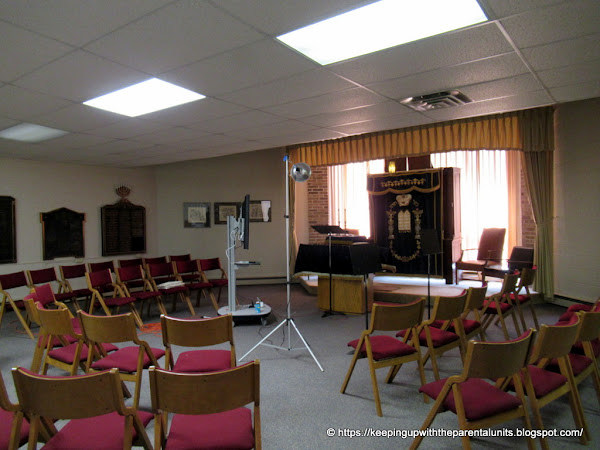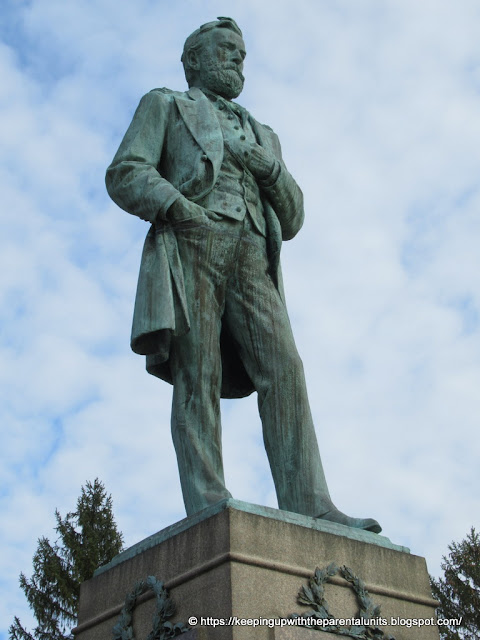Monday, November 30, 2020
Sunday, November 29, 2020
Tuesday, November 24, 2020
Jewish Iowa - Guest Blogger: Bob
On our trip last winter, we tried to spend a Shabbos every few weeks in a Jewish community and enjoyed learning about the community and meeting the people. Due to Covid, that can’t happen this year, but we still wanted to learn about some of the Jewish communities in Iowa, particularly since Lill’s great-grandfather was a shochet in Council Bluffs, Iowa in about 1895. We are not going that far west in Iowa on this trip, but we did visit the shuls in Cedar Rapids and Iowa City.
Cedar Rapids:
Cedar Rapids’ Jewish community dates back to 1895, when several families who had emigrated from Poland and Russia, established a Jewish cemetery. Next, they hired a shochet, and then in 1906, they founded the Beth Jacob synagogue, an Orthodox congregation. In 1922, some of the younger members broke away and founded the Reform Temple Judah. However, in 1949, the two congregations agreed to merge and combine their religious schools using Temple Judah’s building. They now have Reform services on Friday nights and a "Traditional" service one Shabbos morning a month. In 1964, they moved to their current building which we visited. We were given a tour by their Treasurer, Michael Heeren, who has been using the shul as his office due to Covid along with his son who was logging in to Zoom school.
The Traditional service uses the same sanctuary without separate seating for men and women, the same Siddur as the Reform, and is led by their Reform Rabbi. It wasn’t clear to us what the difference is between the services. However, it was nice to see how a small congregation of just over 50 families have been able to maintain their community and this beautiful building. Michael was justifiably proud of their 7 sifre Torah, some over 150 years old.
Iowa City:
In 1857, Moses Bloom settled in Iowa City and opened a clothing store. By 1859 a Jewish cemetery was established. (In 1873, Moses Bloom was elected mayor of Iowa City—becoming the first Jewish mayor of any city in the United States.) With the arrival of a new wave of Russian immigrants in the 1910’s — many arriving via the Baron de Hirsch’s Galveston Plan — the character of the Jewish community changed from being dominated by relatively assimilated German Reform Jews to being dominated by Orthodox Russian immigrants. It’s not clear when the Agudas Achim Congregation was founded, but in 1920, they purchased a house to serve as a synagogue.
Interesting anecdote – In 1921, Agudas Achim repurchased the old Jewish cemetery. It is not known for sure, but it appears that most of the German Jewish families left town as the new wave of Russians arrived, and when they left, they apparently dug up the graves, took the bodies with them, and sold the cemetery.
For many years the synagogue’s rabbi was whoever was sent to be the Hillel Director at the University of Iowa. Although they are not officially affiliated, they were initially an Orthodox congregation, but have had Reform or Conservative Rabbis over the years. Finally, in 1994 they had their first full-time rabbi. After their building suffered water damage and mold in 2012, they renovated a former Gold’s Gym to be their new synagogue. There was no one in their building when we arrived, but here is a picture of their new sanctuary from their website.
By the way, since this is a university town, in addition to a Hillel House, there is also a Chabad House.
Labels:
Cedar Rapids jewish,
Covid Winter,
Frum RV,
frumrv,
iowa jewish,
iowacity jewish
Sunday, November 22, 2020
In Their Dreams!
One of our stops today 

 I have no idea how the movie producers were able to find a cornfield in
Iowa.
I have no idea how the movie producers were able to find a cornfield in
Iowa.
This was the farm owners request: For a photo op? Of what looks just like the baseball field that is
behind my house back home? In their dreams! (We left a more modest donation.)
For a photo op? Of what looks just like the baseball field that is
behind my house back home? In their dreams! (We left a more modest donation.)
Speaking of “In Their Dreams” …
 This is New Vienna, Iowa
This is New Vienna, Iowa
Tomorrow, on to Riverside Iowa, the future birthplace of James T. Kirk!!!


 I have no idea how the movie producers were able to find a cornfield in
Iowa.
I have no idea how the movie producers were able to find a cornfield in
Iowa.This was the farm owners request:
 For a photo op? Of what looks just like the baseball field that is
behind my house back home? In their dreams! (We left a more modest donation.)
For a photo op? Of what looks just like the baseball field that is
behind my house back home? In their dreams! (We left a more modest donation.)Speaking of “In Their Dreams” …

 This is New Vienna, Iowa
This is New Vienna, Iowa
Tomorrow, on to Riverside Iowa, the future birthplace of James T. Kirk!!!
Saturday, November 21, 2020
Shameless Opportunism in the Marketing of a City - Galena and Ulysses S Grant
The city of Galena, IL, former major Mississippi river port and lead-mining frontier boomtown, makes a big deal of its connection to Ulysses S Grant. For example, it hypes:
• The Ulysses S. Grant Home, a national landmark
• A statue of his wife, Julia Dendt Grant
• Grant Park with an impressive statue of Ulysses S Grant• The Galena and U.S. Grant Museum
•
U.S. Grant Memorial Highway, U.S. Route 20
So, what is the connection? Was Ulysses S. Grant born in Galena, or did he live there most of his life, or what?
It turns out that Ulysses S. Grant came to Galena for the first time in April 1860, when he was
38 years old to work in a family owned tannery. He was married with 4 children.
A year later, April 1861, he enlisted in the Civil War.
After the war, August 1865, he returned a hero and was presented with a new, fully furnished home which is now "The Ulysses S. Grant Home, a National Landmark".
A little over a month later, in October, he left for a tour of the US.
From there, he went on to political positions in Washington, DC, eventually serving 2 terms as US President from 1869 - 1877.
The Grants then went on a world tour for 2 ½ years, maybe returned to Galena for a short time in 1880, before moving to NY for the rest of their lives.
A year later, April 1861, he enlisted in the Civil War.
After the war, August 1865, he returned a hero and was presented with a new, fully furnished home which is now "The Ulysses S. Grant Home, a National Landmark".
A little over a month later, in October, he left for a tour of the US.
From there, he went on to political positions in Washington, DC, eventually serving 2 terms as US President from 1869 - 1877.
The Grants then went on a world tour for 2 ½ years, maybe returned to Galena for a short time in 1880, before moving to NY for the rest of their lives.
So by my calculation, Grant lived in Galena a little over a year, and in The Ulysses S. Grant Home, a National Landmark, at most two months
Still, it is absolutely worth visiting Galena, which has transformed itself into an adorable tourist destination with nearly 80% of the city’s homes and commercial buildings listed in the National Register of Historic Places, and the requisite upscale lodging, restaurants, craft breweries, wineries, handmade gift shops, ghost tours, zip line, and goat yoga.
Labels:
Covid Winter,
Frum RV,
Galena,
Galena IL,
IL,
lead mining,
Ulysses S Grant
Subscribe to:
Posts (Atom)














































